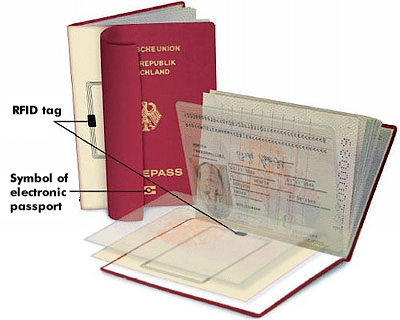electronic passport (ePass)
Since October 2005, the electronic passport (ePassport) has been issued in Germany in place of the conventional passport. Its appearance is the same as that of the previous machine-readable passport, except for an external symbol that identifies it as an electronic passport.
The main difference is a thin film with an RFID tag and antenna embedded in the passport cover. The RFID chip is a microprocessor with a cryptographic coprocessor and a memory of 72 KB. The data stored on the chip is standardized in its structure by the aviation authority ICAO, a sub-organization of the UN. The ICAO has defined 16 data groups, of which the first three are used for the German ePassport. The first data group is also included in the machine-readable passport and comprises the name, gender and date of birth as the MRZ line, Machine Readable Zone (MRZ); in addition, the other data groups include the facial image with the biometric data and the fingerprint.
The personal data is encrypted by a digital signature with two keys. To ensure that the data cannot be read unintentionally, the e-passport has a two-stage access protection system in which the reader uses the machine-readable data (MRZ) to calculate a secret access key that is used for authentication against the RFID tag. The radio transmission between the reader and the RFID tag is also triple DES( 3DES) encrypted.

